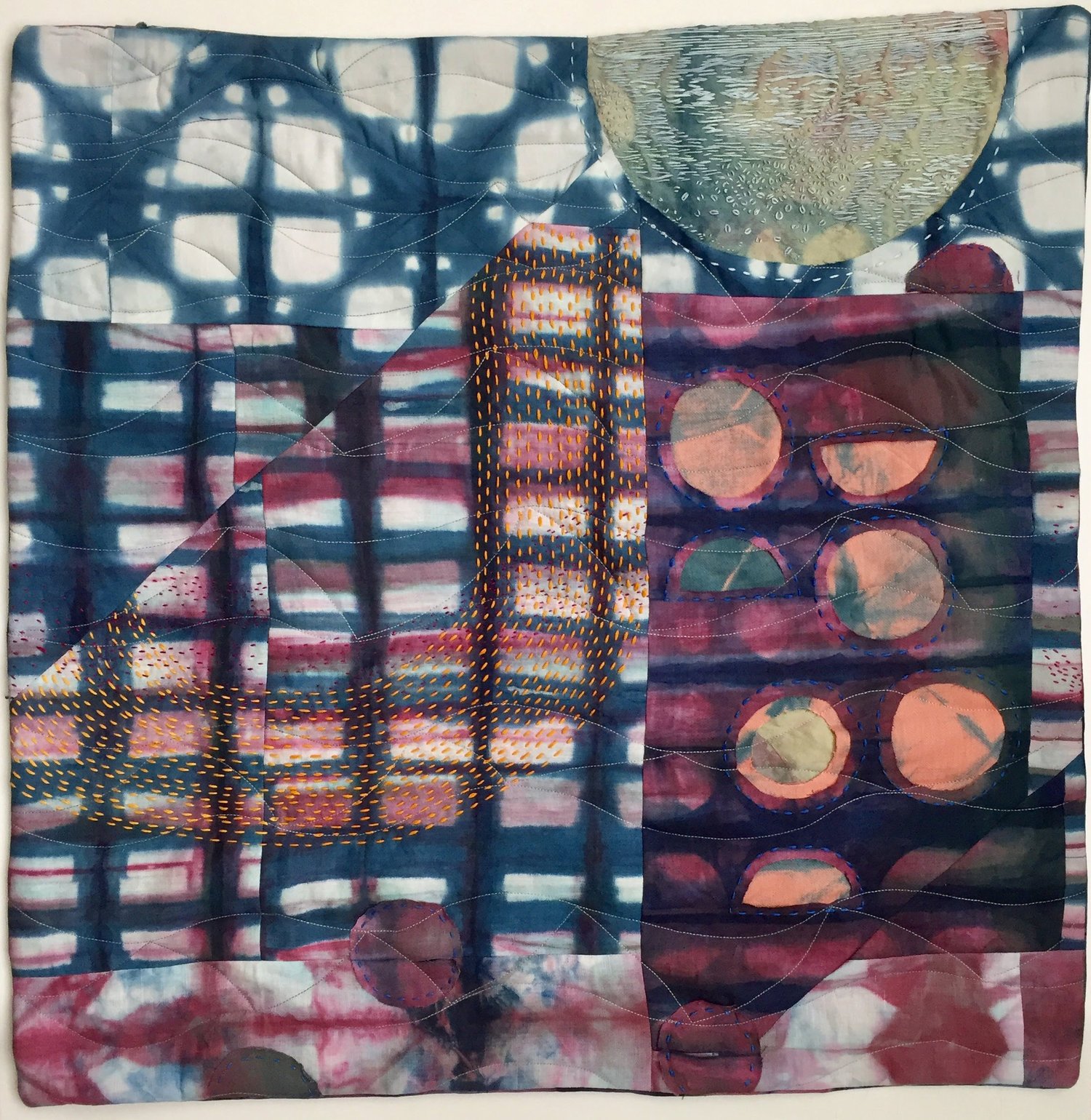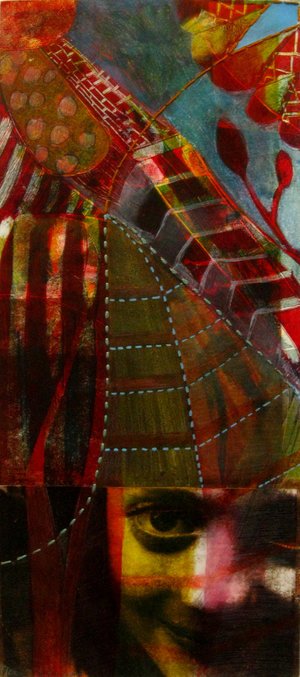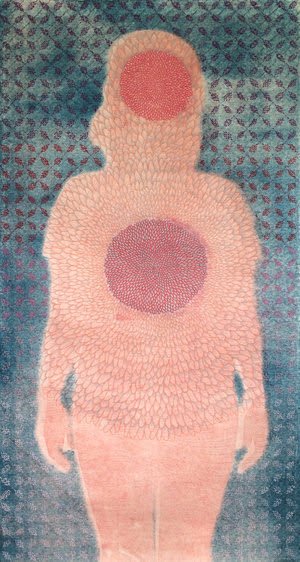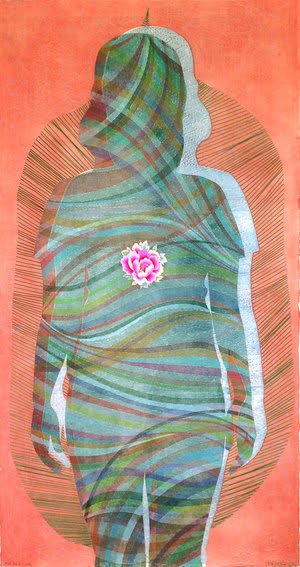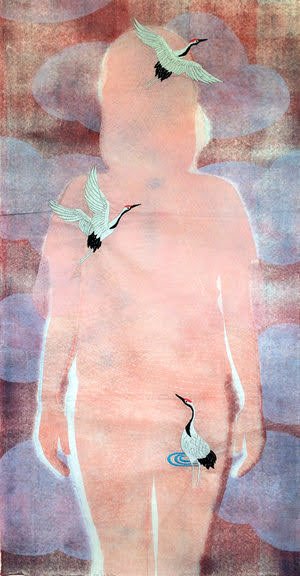Interview with artist Melissa Gill
Melissa Gill is an artist and professor of art at Hendrix College in Conway, Arkansas. Her art like her teaching is mindful and multifaceted. Melissa’s most recent work uses a combination of printmaking, painting, drawing, fabric dyeing, embroidery, and collage to produce visual meditations meant to heighten awareness of self. More of Melissa’s work can be found at Gallery 26 in Little Rock and at her website melissagillart.com.
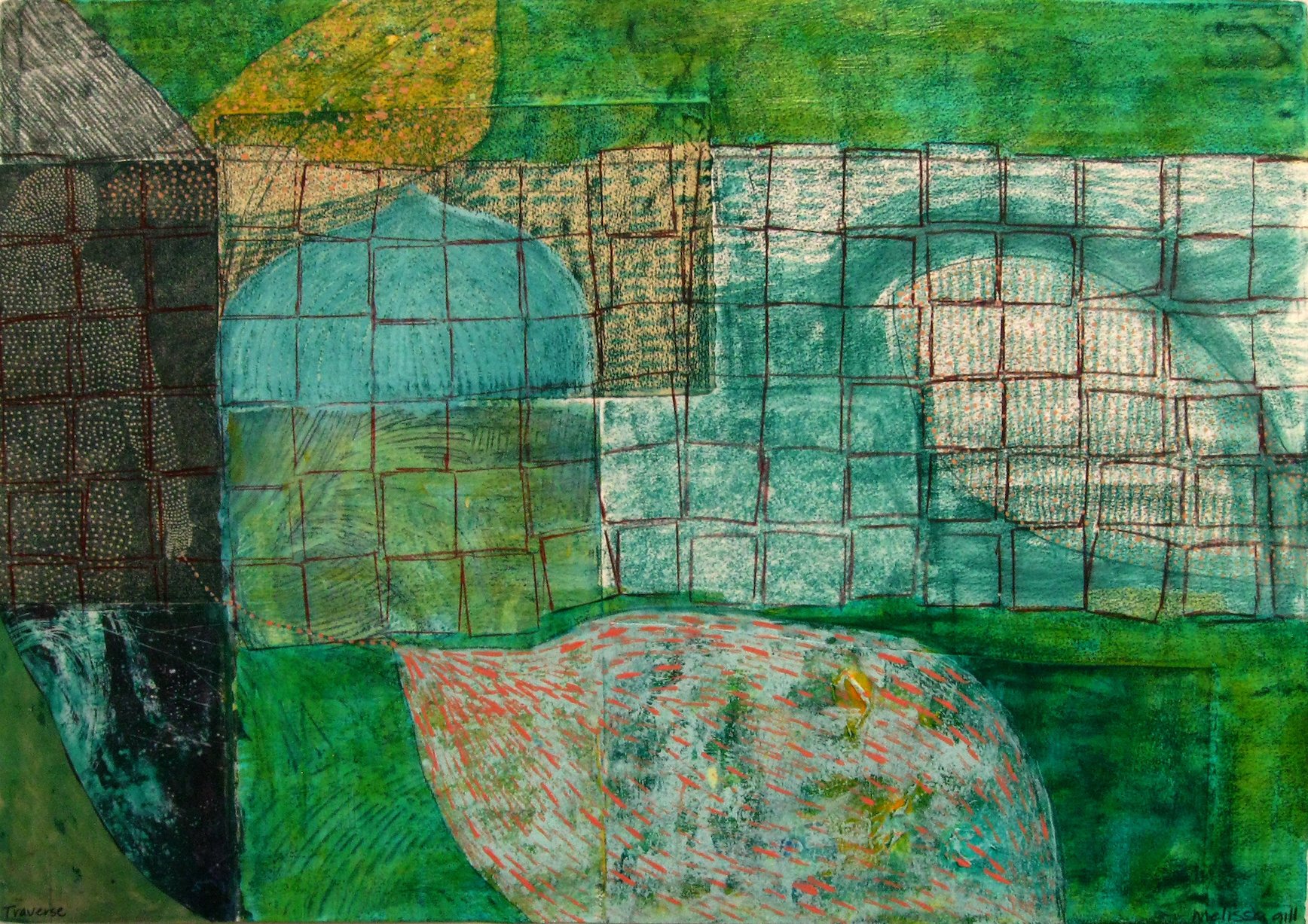
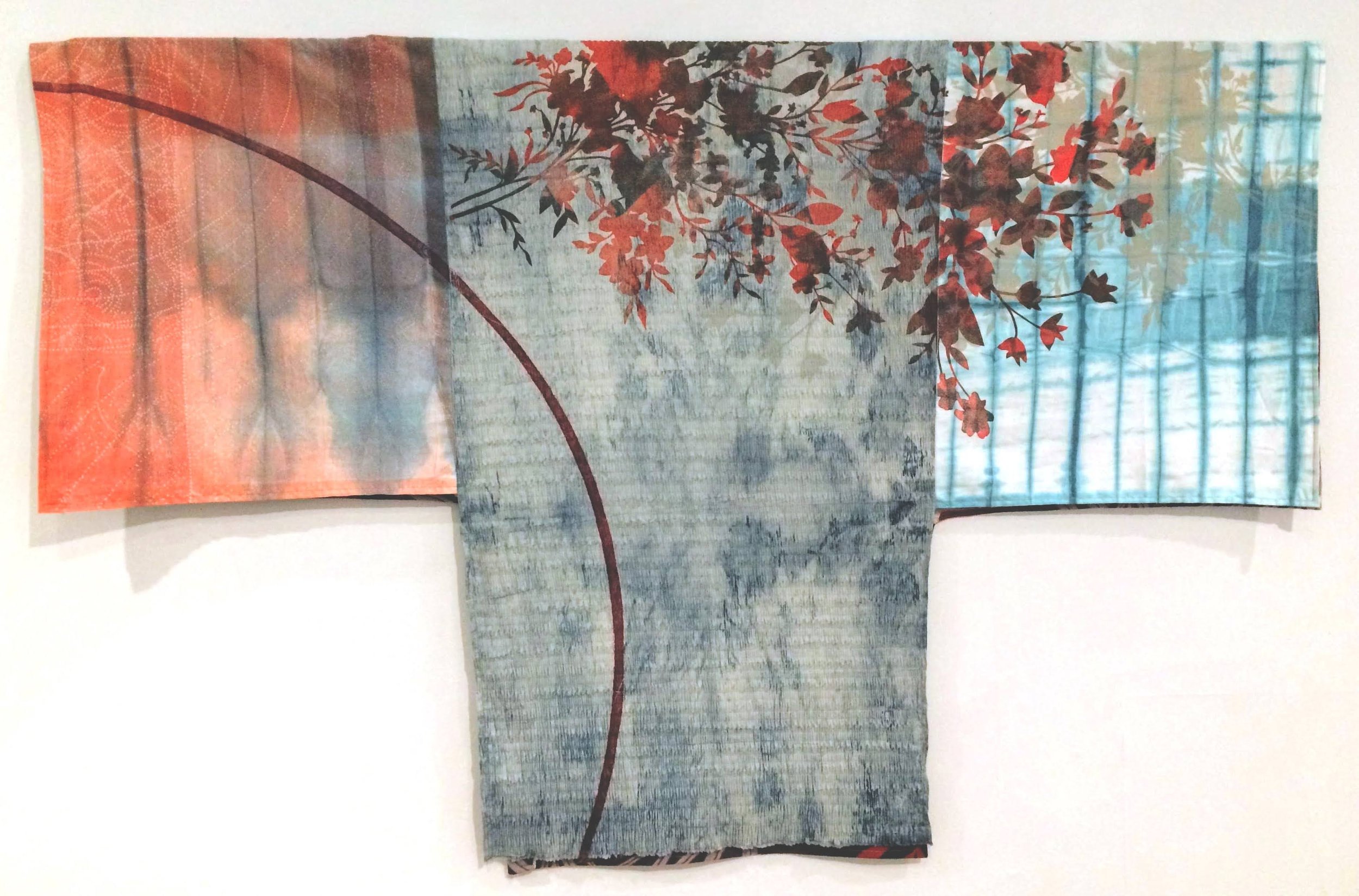

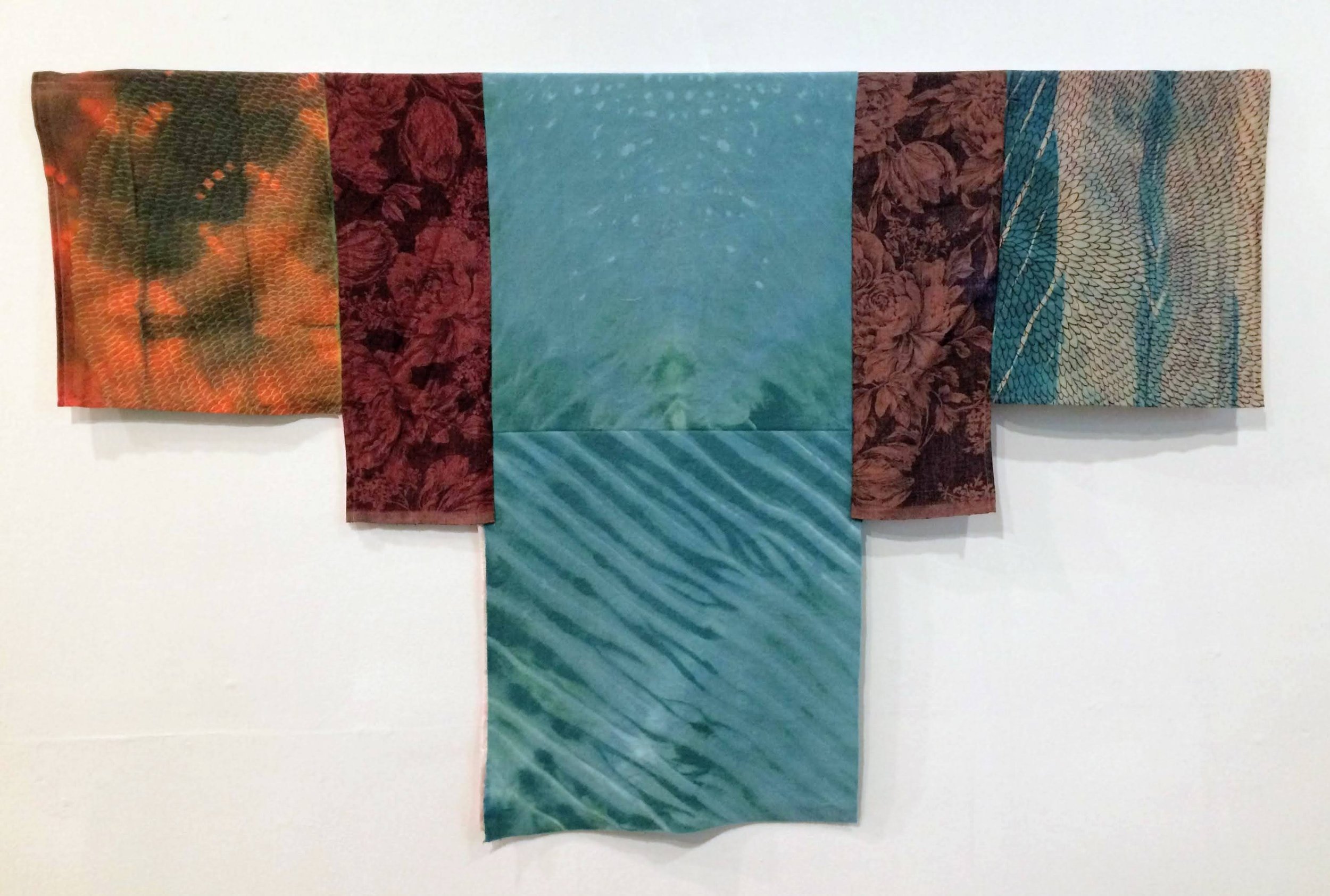
AAS: Melissa, tell me about yourself. Where did you grow up? And how did you end up as a Professor of Art at Hendrix College?
MG: I grew up in Tucson Arizona in the ‘70’s and ‘80s. An important aspect of my early life is that I am a fraternal twin. My sister Erin was born 18 minutes before me, and we were a constant presence in each other’s early lives. We had a young mother who bought us feminist children’s books, taught belly dance classes, did yoga with us, and introduced us to meditation. Our Dad worked for Hughes Aircraft Company. Our brother Ben was born in 1977 when we were 5 years old, and we’ve adored him ever since.
I attended Ricardo Manzo Elementary school where my sister and I were pretty much the only “gringas” in the school. The Mexican American kids really enjoyed making fun of us, basically teasing us for being white girls. I remember every day at recess I checked out a basketball so I could shoot hoops alone and not be bothered by anyone. Because of that and also because the school had a policy of separating siblings into different classrooms, it was a very lonely and yet character-shaping experience for me.
How did I end up as an art professor at Hendrix College? That is a long story! I majored in studio art in undergrad at the University of Arizona in Tucson. My love was drawing, painting and photography, but I had to choose only one for my emphasis. Then my figure drawing professor told me I should take a printmaking class and I was totally hooked. Printmaking is the perfect combination of everything- drawing, painting, and photography. I also loved the poetry of building an image through layers.
That’s the story of how I became a printmaker. I became an art professor by going to graduate school on teaching assistantships- first at Purdue University, and then at Indiana University in Bloomington. After leaving school, I lived in Seattle for a few years, and then took an offer to teach for a year at Purdue as a Visiting Instructor to fill in for a few professors on sabbatical leave. After that I taught for a year at Rockford College in Illinois, and the next year my job search turned up several interviews but no offers. So, I took the opportunity to do something completely different. I got my TEFL Certification and taught Conversational English for a year in Incheon, South Korea. I loved the experience of living in a completely different culture, eating incredible food, meeting so many wonderful people and helping them with their English. However, after a year I decided not to renew my contract. I moved back to the U.S. and renewed my job search for an art professor position. I conducted an epic search, sending out 64+ applications, which resulted in two interviews; one with Hendrix who came through with an offer. That is the brief version of how I ended up where I am today.
AAS: While growing up, was art a big part of your life?
MG: Yes, I think it was. My Aunt Karen was an artist who majored in painting at the University of Arizona, and I remember receiving many gifts of art supplies from her and my other aunts, parents, and grandparents. My parents bought us a big coffee table book featuring Leonardo DaVinci which I absolutely loved, and Erin and I tried to copy his drawings and paintings from that book. One summer when we were in 7th or 8th grade our parents signed us up for a proper drawing course at the Tucson Museum of Art School. We were by far the youngest in the class. That was my first time ever drawing the nude- our parents okayed it because she was a woman. She was also, by the way, an extremely pregnant woman. I still remember that the teacher gave her a kind of transparent cape to wear with a big fancy collar, and I thought she looked incredibly majestic and regal with her huge belly and that cape. It was in that class where the lightbulb went off and I learned how to really look at what I was drawing and to see what I like to call the highlights inside of the shadows, and the shadows inside of the highlights.
AAS: What has teaching taught you about yourself?
MG: I am a huge introvert, so the first thing teaching taught me was how to deal with terror. I am not joking when I say this. I was only 23 years old—a first-year graduate student at Purdue University-- when I taught for the very first time. I was only one or two years older than most of my students. Needless to say, I did survive the experience. I found that, once the nerves subsided, it was actually thrilling to teach what I so loved to do. After 14 years of teaching at Hendrix, I’ve found that I love the challenges of teaching at the beginning level every year. There is always the challenge of keeping the content of the course alive and interesting, but there is also the challenge of maintaining a beginner’s mindset; to inhabit the mind of a total beginner so I can remember the things they need to learn for the very first time.
Teaching has taught me so many things, like when I observe my students being far more critical of their work than I would ever be, it reminds me of my younger self and teaches me compassion. When, after explaining every detail of a new assignment, my students ask me to explain it over and over again, it teaches me patience. It also teaches me to set reasonable boundaries and expectations as well. Teaching has taught me about the energetic dynamic that exists in a room with a group of people, and how each person’s energy affects the whole group. I am much more aware of the energy I bring to groups now than I used to be.
Teaching during the pandemic, especially in March 2020, when all of the students left campus mid-semester, was crazy. I had two weeks to completely re-write my curriculum for 100% remote teaching, having never taught remotely in my life before. I learned that I am resilient and resourceful. In truth, a few Facebook groups I joined- one for art teachers called “How The Heck Are We Going To Do This?” and another one for printmakers called “Printmaking Professors Network” completely saved my bacon. All kinds of art professors across the country were pooling their resources, brainstorming assignment ideas, listing them in google docs and sharing the links for free. I was amazed and so incredibly grateful because truthfully, I was in shock. Some of the things shared were hilariously sarcastic and uncooperative like my friend Kevin Haas who created an at home printmaking assignment which was instructions for making a grilled cheese sandwich. But seriously, watching my students go through all of that taught me to really lead with my heart. It may sound strange but up until that point in my career, my north star was figuring out the “perfect” way to deliver my course content to the students. After the pandemic hit, that flew right out the window and my north star switched to making sure my students were doing okay. These days my students are doing better for the most part. Some struggled to transition from remote learning back to traditional on-campus in-person classes. For my freshman advisees who started college 100% remotely, it was like they had two freshmen years because they were on campus for the very first time their sophomore year. Today, two years later, I think most have adjusted and are well on their way to walking across that stage for graduation.
AAS: Your most recent work incorporates printing, drawing, embroidery, and dyes on fabric to create these wonderful garments. One of my favorites is Midnight Garden Spirit. Tell about that piece.
Midnight Garden Spirit, relief and stencil print, color pencil, embroidery, 35” x 42”
MG: Midnight Garden Spirit is from a series of printed, dyed, and stitched fabric collages that I made to reference the human form and the transitive moment. They are art objects that reference garments, but most are not wearable. In my ongoing research into the textile arts, I have focused my attention on objects that are used for ceremonial or ritual purposes. I’m very interested in the idea of transition or transformation and the transformative experience. I think that’s why I’m drawn to prayer rugs, which show quite a lot of floral motifs and “tree of life” designs, but which also might feature an image of a lamp or lantern- a symbol for Divine Light. While a gorgeous work of art in itself, the rug is also performing a function for the devotee who sits upon it every day to conduct prayers. In Midnight Garden Spirit, I wanted to create an atmosphere, a sense of time and place. My intention is to create an experience for the viewer that brings them into the quiet stillness and beauty of a moment—in this case it’s late at night, surrounded by a garden.
AAS: After you decide on a design, how do you prepare the fabric for printing and/or painting or drawing?
MG: My process of making these textile pieces is much the same way I make paper collages. I generate a large pile of printed and dyed materials (some might mistake this for hoarding), and when I feel I have enough, I start arranging them on the floor or a large table to create my collage. That’s when the basic design is decided upon—then I stitch them together on my sewing machine. The preparation for printing on fabric is to wash, dry and iron it. The preparation for dyeing depends on the type of dye and fabric I will use. For natural dyes on protein fibers (i.e., silk, wool) I scour the fabric—which means I boil it with a gentle detergent. For natural dyes on cellulose fibers (i.e., cotton, linen, hemp) I scour first, then mordant [treat] the fabric. If I am using chemical dyes such as Rit dye, then I only have to wash (scour) the fabric to prepare it.
AAS: Your garments have a very spiritual quality that I think is enhanced by your use of color and contrast. Tell me about Sky Dance.
Sky Dance, relief, shibori dye on cotton, 34” x 52”
MG: Sky Dance combines the shibori dye technique with relief printmaking on cotton. For Sky Dance I was inspired by the murmurations of starlings where hundreds of birds swoop together, forming a kind of shimmering pattern-cloud that travels through the sky. I am obsessed with patterns, especially the naturally occurring ones I find in nature. For me, that kind of beauty is spiritual in a sense. The birds in a murmuration are simply following behind the one in front of them, and yet this extravagant dance performance unfolds powerfully above our heads, so simple and yet so intricate. When the viewer looks at Sky Dance, I want it to remind them of witnessing a murmuration. I want their eyes to play between the positive and the negative shapes and make connections between the abstract geometry of the folded dyed pattern and the other patterns in the piece. There is also a reference to the English translation of the Sanskrit word “dakini” which is “sky dancer.” Though the term has different meanings in different contexts, in Tibetan Buddhism a “Dakini” or “Wisdom Dakini” is a female spirit who embodies enlightened energy.
AAS: I want to ask about some of your works on paper. The effects you obtain with printing and embroidery on paper are quite different from fabric. Veil is just magical. Tell me about that piece and how it was done.
Veil, relief, stencil print, embroidery on paper, 37” x 48”
MG: Thanks for the compliment! Veil is in a way a continuation of the work I did for my master’s thesis at Indiana University. The basic idea is an investigation into the experience of a transformational shift of consciousness. In this case the protagonist is the woman, and she is in the middle of turning from one side to another. Her body has a central axis, but her head and neck have shifted over to one side, so she is facing away from one side and towards the other. In Buddhist thought the six sense perceptions (sight, hearing, touch, smell, taste, and the sixth is thinking or thought) are like the mechanics of how the body/mind receives whatever phenomena arises. Once the sensation is received, translation and interpretation begin in the mind. That process pinpoints the beginning of either happiness or suffering. The whole Buddhist program is centered on the alleviation of suffering, which requires a profound mental shift. In this piece, I was thinking of our senses as a type of lens or “veil.” The flower pattern is the veil which either covers and obscures or lifts and reveals. So, she is either turning away from the color and towards the grey, or she’s getting ready to turn away from the grey towards the color.
The figure is actually a portrait of my friend Mary Robinson, who is now head of printmaking at University of South Carolina at Columbia. Using a photograph as a reference, I free-handed the drawing onto a piece of sintra, then cut it out with wood-cutting tools. I printed the figure onto two pieces of green mulberry paper on an etching press. I cut the flower pattern stencil from a piece of decorative paper, removing most of the little negative shapes around the flower design. Then I rolled the paper stencil with a grey ink on one side, and a copper ink on the other and printed it over the figure. You can see that the flower pattern is a mirror image of itself from left to right. Then when the ink was dry, I hand-stitched the two pieces of paper together and added the embroidered embellishments.
AAS: Already Enlightened – Kathryn is, I guess, a more traditional work on paper. But again, it is how you use selective color and your technical skill that makes it so special.
Already Enlightened, charcoal, acrylic on paper, 60” x 87”
MG: Thank you! Yes, this is a large 5’ x 7’ charcoal drawing with a small diamond pattern painted over the entire figure in acrylic. The title of this piece came straight from a Buddhist retreat I had recently attended in Little Rock where the teacher’s message was that we are all “already enlightened.” This is often talked about with the metaphor of a diamond, where every sentient being is like a pure diamond, awake and aware, which has been buried underneath many layers that obscure its brilliance. So, the process of removing suffering and pain is a process of uncovering our true, joyous nature, which is always there, just covered up.
AAS: Dreaming is another favorite of mine. You created it some 20 years ago. Tell me about it and how what you were creating then has evolved into your current body of work.
Dreaming, charcoal, acrylic, collage on paper, 30” x 44”
MG: Ah, Dreaming is one of my favorites too! This was the first thing I made after graduating with my M.F.A. and finally being done with school. I felt such a weight lifted off my shoulders, and I felt completely uninhibited in the studio. I was free to make work ONLY for me, and not towards any other goal other than the pure love of expression. Figure drawing is one of my true loves, so I drew this portrait of my brother Ben. Then for a while I didn’t know how to finish the piece. I made several sketches of different compositions and that’s how I realized I needed to change the format and attach another piece of paper. The idea of covering his face with butterflies actually came to me in a dream. No joke. Then dreaming itself became the subject of the piece. I was thinking about how dreams flicker like butterflies, and it seemed natural that he should be holding a butterfly net. Very similar to Veil, this piece proposes two versions of (perceptions of) reality on the right and the left side; one more colorful and the other more gray. It may sound strange but when I look back at my early work in graduate school and even undergrad, I can see Buddhist themes in some of it, which makes no sense because I didn’t even start reading about Buddhism until around 1999 and I didn’t start a practice until 2009.
AAS: Where do you think art will take you next?
Stillness, relief, embroidery, color pencil on fabric, 40” x 47”
MG: That is the question I am asking myself right now. I’ve just recently had a significant solo exhibition at the Windgate Museum of Art at Hendrix College that presented my work from the last ~4 years which included a sabbatical project in Fall 2021. Its time now for me to reflect. I know I am going to keep exploring textile art techniques- printing, dyeing and embroidery. There is always so much to learn! I’d love to continue printing onto more transparent fabrics like I have done in Stillness, and I have image ideas floating in my head that incorporate woven linear elements. I am very inspired by the “tree of life” textiles I have discovered online, and I have always felt a love for trees of every kind. I’ve also been imagining taking my recent work and re-arranging it into a new different context. So, there are many directions it might flow. Right now, I am still exploring all of the options. I am so grateful for my friends and colleagues at Hendrix and across greater Arkansas, as well as my friends Daniel Broening and Renee Williams at Gallery 26 who have encouraged and supported me and my work. I’m also incredibly grateful for all of my students (who I actually consider to be my teachers) at Hendrix and also the AMFA, formerly known as the Arkansas Arts Center. I can’t do what I do without all of your support, so thank you from the bottom of my heart!
